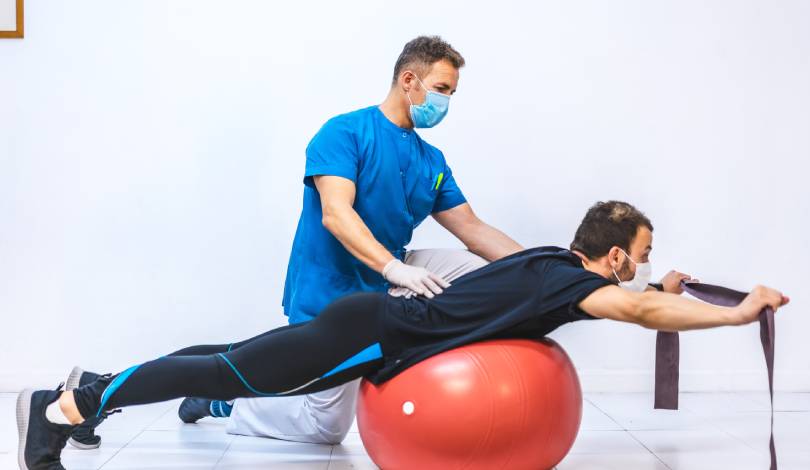Synopsis
Chronic back pain can significantly impact daily life, limiting mobility, reducing productivity, and deteriorating mental health. Whether caused by injury, sedentary lifestyle, or post-surgical complications, persistent back pain requires more than just medication or temporary fixes. Fortunately, physiotherapy for back pain offers a science-backed and sustainable solution.
This blog explores the multiple dimensions of physiotherapy as a treatment for chronic back pain. From effective physical therapy treatment for back pain to targeted interventions like backache physiotherapy and bad back physio, we’ll cover everything you need to know to understand the healing process. We’ll also look into how physiotherapy after surgery helps accelerate recovery and how physio for sore back plays a vital role in restoring function.
We will also provide actionable insights into choosing the right physiotherapy for lower back pain and why working with trained professionals is critical. This guide aims to help patients make informed decisions and commit to a healing journey rooted in evidence-based care.
Introduction to Chronic Back Pain
Back pain is one of the most prevalent health concerns globally, with over 80% of individuals experiencing it at some point in their lives. It can stem from musculoskeletal strain, disc problems, degenerative conditions, or poor posture. Chronic back pain persists for more than 12 weeks and often requires more than rest or medication.
Physiotherapy plays a pivotal role in treating back pain through tailored programmes that target the root cause rather than just symptoms. With the right approach, even long-standing issues can see significant improvement.
Causes and Risk Factors
Understanding what causes back pain is the first step in effective management. Common causes include:
- Sedentary lifestyle and poor posture
- Herniated discs or spinal stenosis
- Muscle strain or ligament sprain
- Osteoarthritis and degenerative disc disease
- Previous surgeries or trauma
Knowing your risk factors helps in tailoring the right physiotherapy for lower back pain.
Role of Physiotherapy in Managing Back Pain
Physiotherapy for back pain employs a combination of manual therapy, targeted exercises, and patient education. The goal is to reduce pain, restore movement, and prevent recurrence. Key components include:
- Postural training
- Core strengthening
- Manual mobilisation and manipulation
- Dry needling or soft tissue release
A customised plan is essential for effective outcomes in backache physiotherapy and bad back physio.
Key Techniques in Back Pain Physiotherapy
Here are some commonly used techniques:
- McKenzie Method for spinal extension
- Core stabilisation with Pilates-based exercises
- Heat and cold therapy for inflammation
- Electrotherapy (TENS) for pain modulation
These are frequently employed in physio for sore back treatments. A qualified therapist ensures these techniques are adapted to each patient’s needs.
Recovery After Surgery: How Physio Helps
Post-operative recovery often demands a structured rehabilitation protocol. Physiotherapy after surgery helps patients regain flexibility, strength, and endurance. Techniques include:
- Scar tissue mobilisation
- Gradual range of motion exercises
- Progressive resistance training
It is critical for avoiding complications and achieving full recovery.
Lifestyle Changes and Home Exercises
Long-term success with physical therapy treatment for back pain depends on incorporating healthy habits:
- Daily stretching routines
- Ergonomic workspace adjustments
- Regular aerobic exercise
- Mindfulness and stress management
These lifestyle modifications complement in-clinic treatments.
Why Choose Orthocure Clinics
At Orthocure Clinics, we offer:
- Personalised treatment plans for back pain physical therapy treatment
- State-of-the-art technology like MedX for spinal assessment
- Expert therapists with experience in physiotherapy for back ache and post-surgical care
Patients receive evidence-based care aimed at long-term relief and functional improvement.
Conclusion
Chronic back pain need not be a life sentence. With targeted physiotherapy for back pain, patients can regain control, reduce dependence on medication, and return to active living.
Orthocure Clinics is committed to empowering your recovery through compassionate, clinical, and comprehensive care.
FAQs
What is the most effective physiotherapy treatment for back pain?
The most effective treatments combine manual therapy, core strengthening, posture correction, and patient education. A customised approach tailored to individual needs ensures faster and longer-lasting relief.
Can physiotherapy help with post-surgical back pain?
Yes, physiotherapy is crucial after surgery to improve mobility, reduce scar tissue, and regain muscle strength. It helps patients return to daily activities safely and confidently.
How long does it take to see results from physiotherapy for back pain?
Some patients experience relief within a few sessions, while others may need a few weeks of consistent treatment. Progress depends on the severity of the condition and adherence to the plan.
Is back pain physiotherapy suitable for all age groups?
Yes, physiotherapy is safe and effective for all ages. Treatment plans are adjusted based on individual needs, health status, and lifestyle factors.





